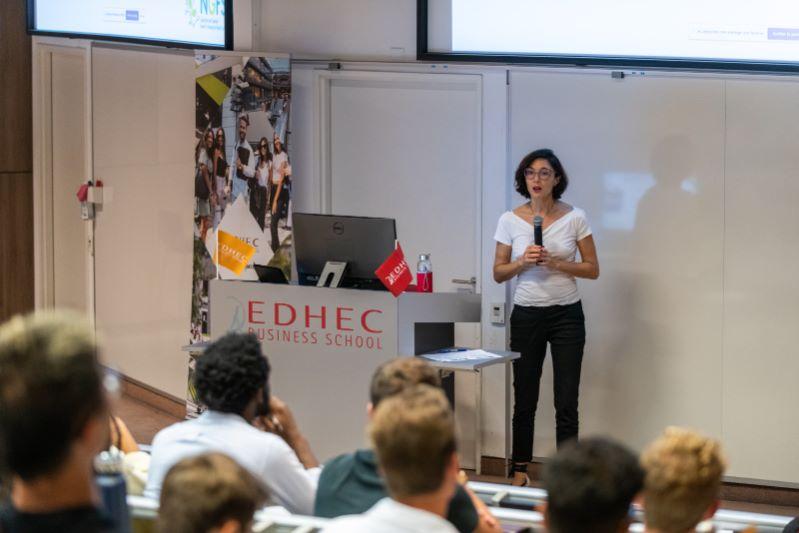Climate finance: Measurement challenges for the financial industry
Irene Monasterolo, professor of climate finance and director of a research programme at the EDHEC-Risk Climate Impact Institute on the Impact of Finance on Climate Change Mitigation and Adaptation, teaches Measurement Challenges for the Financial Industry to MSc in Climate Change & Sustainable Finance students. She received the 2022 Banque de France Young Researchers in Green Finance award and has developed research on climate finance in collaboration with central banks and financial regulators, including the European Central Bank and the European Insurance and Occupational Pension Authority. Professor Monasterolo details her research and gives us some insights into her class.

What can you tell us about your field of research?
My research is about climate and sustainable finance and has developed around interconnecting the two streams. On the one hand, I have developed metrics and models to identify and assess physical climate and climate transition risks for investors, most notably a climate stress-test of the financial system. On the other hand, I have analysed under what conditions and to what extent climate policies and regulations can affect economic decarbonisation and the potential side-effects of inequality on financial stability.
As mentioned, you co-developed a climate stress-test of the financial system and the EIRIN Stock-Flow Consistent macro-financial model. Can you explain what these are?
In 2017, with a group of co-authors, I published a climate stress-test for the financial system in Natural Climate Change. The climate stress-test provided the first framework for translating climate scenarios into adjustments in firms’ financial performance, into the value of financial contracts and into investors’ risk metrics (such as the climate Value at Risk). It also includes a financial network model to assess the largest losses an investor could face if certain climate scenarios were to be realised, including lost reverberation, the so-called “contagion effect”.
The climate stress-test introduced a framework that became a reference for financial institutions, both central banks and financial regulators, but also banks, insurance companies and pension funds. In this regard, I collaborated with several central banks and financial regulators, which applied a climate financial risk assessment either by themselves or in collaboration with myself and my co-authors. We worked for instance with the European Insurance and Occupational Authority (EIOPA).
The EIRIN model is a macro-financial model that includes heterogeneous agents and sectors of the economy and financial sector. Its peculiarity is that each agent and sector is represented by its own balance-sheet entries, which are interconnected in a network. This allows for the transparent tracing of the shock transmission and circulation through the balance-sheet entries of each agent, as well as for the identification of potential amplification points.
Furthermore, the agents and sectors are endowed with behavioural rules and heuristics. They can depart from rational and forward-looking expectations in the context of the deeper uncertainty that characterises climate change and the low-carbon transition. The model has been used to analyse the conditions under which countries could finance low-carbon investments through different green fiscal and financial initiatives, including carbon tax and green sovereign bonds, and to measure the implications for economic carbonisation and carbon stranded assets in the economy and banking sector, as well as for inequality and financial stability. The model has also been used to analyse to what extent investors’ climate sentiment – that is, their expectations about climate policy credibility – affects the low-carbon transition in the economy.
More recently, EIRIN has been used in collaboration with the World Bank to assess the macroeconomic and financial impacts of compounding physical climate risk and pandemics in selected countries. Lastly, it has been used in collaboration with the European Central Bank to assess the double materiality of physical climate and climate transition risk in the euro-area economy and banking sector.
Indeed, your latest paper deals with the double materiality of climate physical and transition risks in the euro area. Can you sum up its main findings for us?
Our research investigates the double materiality of climate physical and transition risks in the euro-area economy and banking sector and analyses the role of investors’ climate sentiment in fostering or hindering the low-carbon transition process. First, by tailoring the EIRIN Stock-Flow Consistent model, we provide a dynamic balance-sheet assessment of the Network for Greening the Financial System scenarios.
We find that an orderly transition achieves early co-benefits by reducing carbon emissions (12% less in 2040 than in 2020) while supporting growth in economic output. In contrast, a disorderly transition worsens euro-area economic performance and financial stability, while high physical risks can make real Gross Domestic Product (GDP) shrink by 12.5% in 2050 compared with an orderly transition.
Second, by extending the concept of climate sentiment, we analyse how firms’ expectations on climate policy credibility affect their investment decisions in high- or low-carbon goods and the impact on economic decarbonisation. We find that firms that have trust in an orderly policy introduction and anticipate carbon price scenarios switch earlier to low-carbon investments. This, in turn, helps to decrease the risk of carbon stranded assets for the economy and for the banking sector. Our results highlight the crucial role of early and credible climate policies as a signal to investors in the low-carbon transition.
You teach Measurement Challenges for the Financial Industry to MSc in Climate Change & Sustainable Finance students. What are the main concepts they will learn?
Students will learn about the theory and practice of sustainable finance. They gain an understanding of international policy and regulations on sustainable finance, including leading initiatives. They learn how to use climate scenarios for climate financial risk assessment and climate stress-testing, as well as the pros and cons of using different metrics (such as carbon footprint) or classifications (for example, the EU Taxonomy) for climate financial risk disclosure. Lastly, they learn how to analyse whether markets are pricing climate risks and whether it pays for investors to decarbonise their portfolios, for example, via Environmental, Social and Governance (ESG) investments or green bonds.
What are the main climate-related financial risks?
We talk about three main types of risk. The first is physical risk, which relates to the economic and financial impacts of natural disasters (acute risks) and long-term changes, for example, in temperatures, sea-level rise and biodiversity losses (chronic risks). In contrast, transition risks are linked to either technological shocks or policy and regulatory changes in the context of the low-carbon transition, particularly if these changes occur late and suddenly, meaning that investors may not be able to fully anticipate their impacts on prices. Lastly, litigation risks pertain to the implementation of policy regulation in certain legislative domains.
You teach Sustainable Finance to MSc in Accounting & Finance students. Why is it essential for students on this MSc course to have a sound understanding of environmental finance? What will you introduce them to?
It is crucial for students to learn about sustainable finance, because it is becoming a major player in the market. Sustainable investing is approaching almost half of the market and is proving to be countercyclical in terms of investment, even in times of crisis, such as the Covid-19 pandemic. Sustainable investing is becoming more and more important for investors, both in terms of investment opportunities and risk diversification, but also for reputational reasons and in response to changing consumer preferences and demand. It is also important for investors that have to respond to shareholders.
Finally, there are ever more job opportunities when it comes to analysing portfolio impact, portfolio alignment with net zero portfolios, or portfolio rebalancing to create greener portfolios. These opportunities abound in private industry, central banks and financial regulators.
Are there books or publications students should read in preparation for your courses?
In all classes, I provide students with both “grey literature”, that is, reports from leading think tanks and organizationss, such as the Carbon Tracker Initiative or the United Nations Environment Programme Finance Initiative (UNEP-FI), as well as academic publications on sustainable finance. I have also selected chapters of the Sixth assessment report of the Intergovernmental Panel on Climate Change (IPCC) for students to read, in particular, chapter 15 on investments and finance.
Will students work on business cases?
Every lesson is divided into two parts. The first part focuses on theory, concepts, and an explanation of metrics and methods. The second part focuses on application through real case studies, such as company disclosure of Scope 1, 2, and 3 emissions and the analysis of greenwashing. We also look at company sustainability reports, learn how to simulate the climate scenarios used by the Network for Greening the Financial System, and how to price the green factor and how to perform climate-adjusted financial valuation of securities.
What do you expect your students to have mastered on completion of your courses?
I expect them to understand the main concepts of climate and sustainable finance, such as the difference between climate mitigation and climate adaptation, the difference between an orderly or disorderly transition, the different climate scenarios used in the financial system, including the IPCC, the difference between climate financial risk disclosure and risk assessment, and the challenges related to disclosure and risk assessment. They will also learn about the main types of sustainable finance instrument (green bonds, ESG and so on), their characteristics and limitations, and what we mean by portfolio alignment or the temperature of a portfolio.



